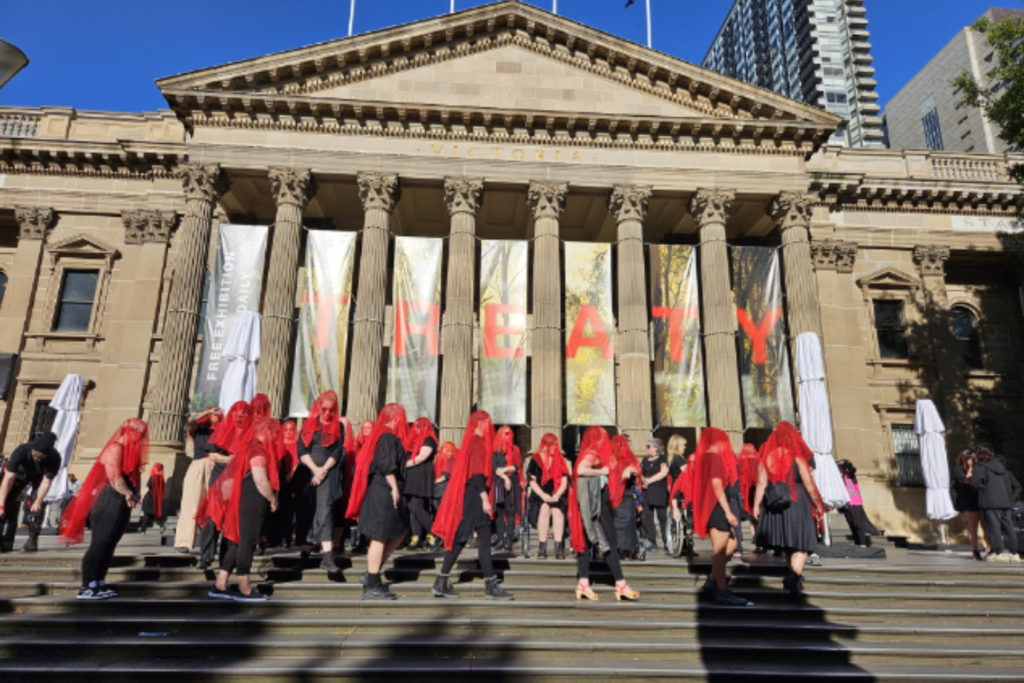Last Friday, 101 women answered a call out from organizer Fleassy Malay, to stand on the stairs of the Victorian State Library for thirty minutes of silent protest, for the 101 women killed by violence in Australia in 2024.
Their uniform? Black clothing, with a red veil over their faces. A red sign in front of them read:
101 Women Killed in 2024.
Of those 101 women killed, 80 per cent knew their killers, 56 per cent were victims of domestic violence and 90 per cent of the killers were male, according to Sherele Moody of Australian Femicide Watch.
I watched from a nearby statue in the shade. These brave women stood on the stairs, faces in the sun as it descended the sky on a gorgeous, warm Melbourne evening.
Dr Niki Vincent, the Public Sector Gender Equality Commissioner for Victoria, gave the opening address at the protest, highlighting how the root cause of these women’s deaths – gender inequality – is as pressing as ever, as the number of women killed in Australia over the past few years has climbed. In 2021, 44 women were reported as killed. In 2022 it was 56 and in 2023, 64 women killed.
This silent protest was interrupted by a man who was passing by who asked, repeatedly, and in an agitated voice, why the protest was “specifically about women”, pointing out that men get killed too. I heard another three men, strangers, repeat a variation of this accusation towards the end of the protest, one towering over a volunteer: “Where are the men? They get stabbed too, you know”.
I felt on edge being at this protest and not quite safe – hyper-aware of the anger protesting women can stoke in men. And I was only watching, safely in the shade of the statue, where I could walk away at any time, pull on a navy-blue jumper over my black sports clothing, and shamefully pretend I was never part of it.
So where are the men? Where are the 90 or so men who are believed to have killed 90 per cent of the women killed last year? Should we have blacked out cut-outs of their bodies next to each of these women, to make it clear why those women cannot stand on the stairs today? To make it clear to any passerby that these are not just murdered women, they are women murdered by, for the most part, men?
And what about other men? Men like those on the stairs, standing in solidarity, with the 101 women standing there in black and red. Men who have lost a loved one to the hands of another man? Men who care. Men who want change. Boys who have become men who have been affected by domestic violence. There were some men scattered in the crowd or on the stairs in the sun. But not many and not enough. How we do better include them in this conversation, in these protests, in this movement, in this urgent need for change that is literally in their hands?
Other than the angry, agitated men asking ‘where the men were’, I was struck by the shoes of the 101 women on the stairs. All in black, with red veils over their faces. But their shoes told another story: the were all different. Shining, sparkling or dull in the sunlight. Black, white, yellow, orange, red. Striped, block coloured, patterned. High top, laces, slides. Heeled, flat, somewhere in between. Flashes of individuality in the darkness, the silence, the absence, the solidarity, the protest.
What shoes were the women, the 101 women wearing who were alive at the start of 2024, with their lives ahead of them, when they were murdered? What shoes did she slide on or lace up, for the last time, unaware they would be the last pair of shoes she would be allowed to wear? What places had she walked in those shoes – the local café, the gym, work, school, around the park, the familiar streets of a place she called home? Which people had she sat next to in those shoes – her parents, her friends, her sister, her brother, her children, her colleagues, a stranger she exchanged a smile with on the tram, Him?
Or perhaps she was barefoot when she was killed? No shoes, not expecting she’d need to flee a home, a footpath or a car tonight. She doesn’t need to go anywhere tonight. Feet bare on the carpet, the cool tiles, the floorboards, on which her footsteps had echoed down earlier that evening, as she tucked her son into bed, and gave him the last good night kiss he would receive from his mother. Tomorrow, and every day after, for that little boy’s life, His mum would be dead.
And His shoes? What shoes was He wearing that night? The night He murdered her, a woman He perhaps loved, claimed to love, once loved, a woman who perhaps was the mother to His children, a woman He perhaps had known a long time, who perhaps was with Him when He bought His shoes on a rainy day that on another rainy day He’d wear to kill her? Did He know, putting His shoes on, that rainy day, that they would be the shoes that would carry Him, hold Him, while He choked her, held her and stabbed her, beat her?
What does He feel in that moment, the moment He robs her of any more feelings, after commanding her final feeling of unspeakable terror? Or the following moments, where all that can be heard is his breathing, slowly slowing, his racing heart, the tick of a clock on the wall, perhaps the cries of a child, perhaps the distant traffic, perhaps a wail of sirens, winding past the streets of her loved ones, in their last slumber before His robbery alters their lives forever, as life ticks on and on, without her breathing, without her heart beating.
How did He get here, a murderer? How did she get to be here, murdered beside him?
When was this path laid? When did the control, the coercion, begin? The manipulation? The jealousy? The gas-lighting? The isolation? The silencing? Violence – sexual violence, physical violence, emotional violence – domestic violence? When did His warping of reality seep into hers, when did He make it hers? How long had she been living with a deep sense of unease, an instinct, or perhaps the knowledge that something wasn’t right? How many times had she tried to leave? How many times had she reached out for help? How many times had He? How many times had she alerted the police? How many people knew about His behaviours? Was there help available and accessible to her? Was there help available and accessible to Him?
What if the path had deviated? What if she got away on a different night, where she was able to leave? If she was allowed to leave, if He let her leave, if perhaps, with help, she escaped and continued to live her life without His blessing? Would He have found another woman, and history repeated itself, but culminated in a different woman bleeding next to Him and His heavy breathing, her bloodless bare feet splayed out, bare in the pretence of safety of home?
Other paths? Of course, the ideal path is the path of prevention, facilitated by ongoing efforts towards gender equality. But often, He’s part way down a misogynistic path already. Can there be a deviation where He gets help? Where a friend suggests, insists, demands, helps Him get help? Where He learns to identify His behaviours of coercing, controlling, gaslighting, what underlies them, and how to stop them? One where He understands He is not entitled to, and nor does she owe Him, her body, her time, her love, her staying, her self? Where He learns to cultivate healthy relationships with women already His life, with His children, with His male friends, with Himself? Could this be a real path for Him?
Could there be a path where that leads him to stand in the crowd next to me, in solidarity, for the women killed, perhaps one less woman, by other men, not him? Where he can calmly explain to the agitated, angry man, making the women around him uneasy, where the men are, and why he is here, with the women?
f you or someone you know is experiencing, or at risk of experiencing, domestic, family or sexual violence, call 1800RESPECT on 1800 737 732, text 0458 737 732 or visit 1800RESPECT.org.au for online chat and video call services.
If you are concerned about your behaviour or use of violence, you can contact the Men’s Referral Service on 1300 766 491 or visit http://www.ntv.org.au.
Feeling worried or no good? No shame, no judgement, safe place to yarn. Speak to a 13YARN Crisis Supporter, call 13 92 76. This service is available 24 hours a day, 7 days a week.


